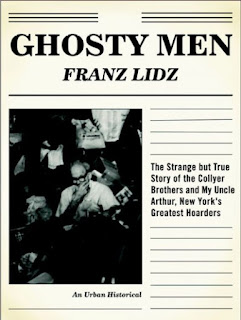
I can understand how hoarding starts. The rubber bands on celery are reusable. Newspapers have more articles than you can read today. Plastic milk jugs seem too good to throw away or even recycle. Swizzle sticks come in a variety of shapes and colors; how many you wonder? There are so many good books at used book sales really cheap. You have every episode of I Love Lucy and Lassie on VHS. Neighbors are leaving really good things by the curb on clean-up day. That old PC might be a collector's item some day. There is always a little more room for a few choice items in the house or apartment.
Some hoarders take their obsession to extremes. Franz Lidz writes about three such men in his compact book Ghosty Men: The Strange But True Story of the Collyer Brothers, New York's Greatest Hoarders. As the subtitle indicates two were Homer and Langley Collyer, about whom E. L. Doctorow has also written a recent novel. The third hoarder was Lidz's own Uncle Arthur Lidz. By mixing chapters about the Collyers, celebrities after stories ran in all of the New York newspapers about their bizarre hoarding in 1930's-1940's Harlem, with chapters about his uncle, the author makes the subject more immediate and almost understandable. Readers may even notice similar behaviors in their own friends and family or even themselves.
Lidz also shows that the lives of hoarders do not have to end as tragically as those of the Collyers. Families will, however, have to learn when to tolerate and when to intervene to protect their kin. There are no easy answers, but Lidz's book may help some concerned readers. For others, Ghosty Men will be a memorable and well-told story bound to keep them up late.
Lidz, Franz. Ghosty Men: The Strange But True Story of the Collyer Brothers, New York's Greatest Hoarders. Bloomsbury, 2003. ISBN 158234311X.



No comments:
Post a Comment